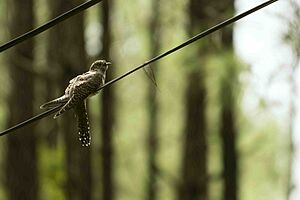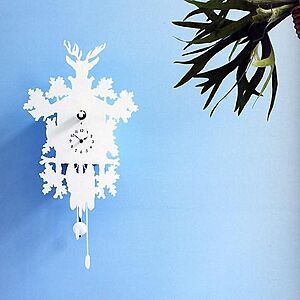Cuckoo clock facts for kids
A cuckoo clock is a special kind of clock that uses a pendulum to keep time. It makes a sound like a cuckoo bird's call every hour. A small, automated cuckoo bird also pops out and moves when the clock chimes. Some cuckoo birds flap their wings and open their beaks, while others just lean forward. This cuckoo sound mechanism has been used for a very long time, since the mid-1700s, and it hasn't changed much since then.
No one knows for sure who invented the first cuckoo clock or where it was made. However, many people believe that most of its development happened in the Black Forest area of southwestern Germany. This region, in the state of Baden-Württemberg, is where the cuckoo clock became very popular. From the mid-1850s onwards, cuckoo clocks were sent all over the world. Today, they are a favorite souvenir for tourists visiting Germany, Switzerland, and Austria. The cuckoo clock has become a well-known symbol of Germany.
Contents
What Makes a Cuckoo Clock Special?
Most cuckoo clocks today have a very traditional look. They are usually designed to hang on a wall. You'll often see them in two main styles: "traditional" (also called "carved") or "chalet" style.
In the "traditional style," the wooden clock case is decorated with beautiful carvings of leaves and animals. A small door opens, and the cuckoo bird appears to make its call. The bird often moves as the clock chimes, usually by a small arm that lifts its back.
Some modern cuckoo clocks, called quartz cuckoo clocks, have cool features. Many include a sensor that can tell if it's dark. When the lights are turned off at night, the clock automatically stops chiming the hours. Other quartz clocks are set to be quiet during certain nighttime hours. This helpful feature, whether controlled by light or a pre-set schedule, is called 'night silence'.
The Story of Cuckoo Clocks
The first known description of a cuckoo clock was written in 1629. This was many years before clock-making became big in the Black Forest. An important man from Augsburg named Philipp Hainhofer wrote about it.
It's not clear who built the very first cuckoo clocks in the Black Forest. But everyone agrees that this unique clock with its bird call quickly became popular there. By the mid-1700s, several small clock-making shops were already making cuckoo clocks with wooden gears. This means the first Black Forest cuckoo clocks were made between 1740 and 1750. The earliest ones from the Black Forest had faces decorated with paper.
In the early 2000s, the cuckoo clock became popular again. Designers started creating new clocks with different materials, technologies, shapes, and colors. These modern designs were unlike anything seen before in cuckoo clock history.
Where to See Cuckoo Clocks
If you want to see lots of cuckoo clocks, you can visit museums. In Europe, there's the Cuckooland Museum in the UK. In Germany, you can find them at the Deutsches Uhrenmuseum and the Dorf- und Uhrenmuseum Gütenbach. In the United States, one of the largest private collections open to the public is in Minneapolis. It has more than 300 cuckoo clocks!
Images for kids
-
A spring-driven Reguladora timepiece, Portugal, 1950s. The same model is in the collection of Senator John Heinz History Center.
See also
 In Spanish: Reloj de cuco para niños
In Spanish: Reloj de cuco para niños















